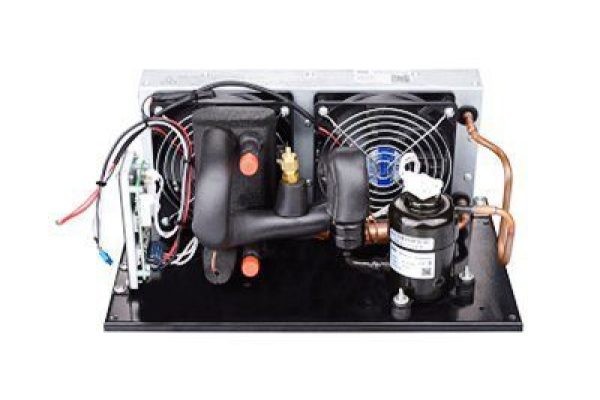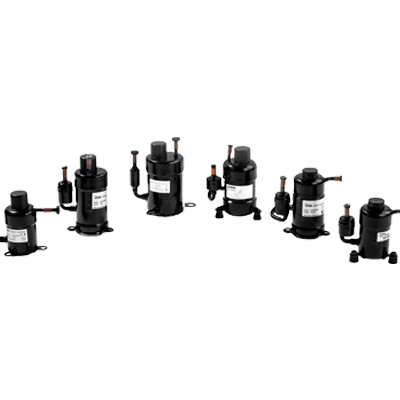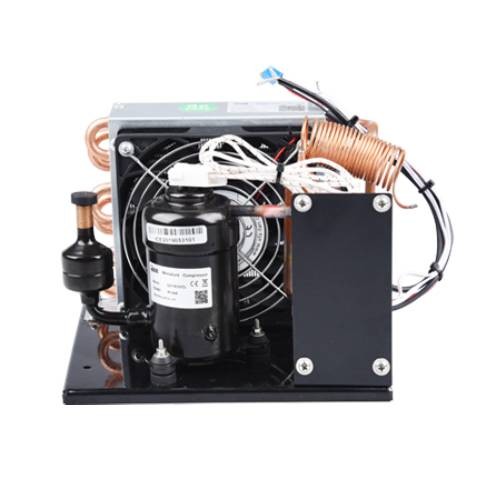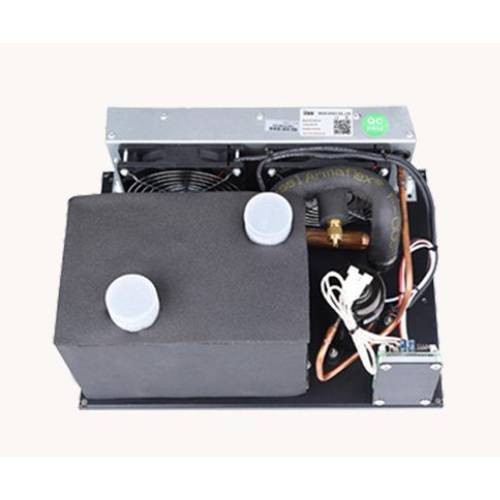Introduction

"Arctic Active Cooling. Endless Possibilities. We capture new technologies in mobile and compact cooling. Full-size cooling in a miniature design, customized to make your device stand out with innovative thermal management."
When it comes to cooling systems, chiller compressors play a crucial role in maintaining optimal temperatures. Understanding the basics of chiller compressors is essential for anyone looking to maximize efficiency and performance in their cooling systems. In this article, we'll demystify chiller compressors and explore their key functions and features.
Understanding the Basics of Chiller Compressors
Chiller compressors are the heart of any chiller system, responsible for pumping refrigerant through the system to absorb and remove heat from the air or water. These powerful machines come in various types, each with its unique features and capabilities. Understanding how these compressors work is vital for selecting the right one for your specific cooling needs.
The Role of Compressors in Chiller Systems
Compressors are integral to chiller systems as they regulate temperature by compressing refrigerant gas, increasing its pressure and temperature before it enters the condenser. This process allows for efficient heat transfer, ensuring that the chilled water or air maintains the desired temperature within the system. Without a properly functioning compressor, a chiller system would not be able to effectively cool its intended environment.
Demystifying Chiller Compressors
Chiller compressors can often seem complex and mysterious, but with a clear understanding of their function and operation, users can make informed decisions about their selection and maintenance. By shedding light on how these essential components work within a chiller system, we aim to provide clarity on what makes them such critical elements in cooling technology.
What is a Chiller Compressor?

Chiller compressors are the heart of chiller systems, responsible for cooling and regulating the temperature of the chilled water. They come in various types, including reciprocating, centrifugal, and screw compressors, each with its unique features and advantages. Understanding the different compressor options is crucial for selecting the most suitable one for your specific cooling needs.
Types of Compressors Used in Chillers
Reciprocating compressors are known for their efficiency and reliability, making them ideal for smaller chiller applications. Centrifugal compressors are preferred for larger capacity chillers due to their ability to handle high cooling loads efficiently. Screw compressors offer a balance of efficiency and flexibility, making them a popular choice for medium-sized chiller systems. When it comes to regulating chiller temperature, each type of compressor plays a crucial role. Reciprocating compressors excel at maintaining consistent temperatures in smaller chillers, ensuring that the cooling process runs smoothly without any fluctuations.
How Compressors Regulate Chiller Temperature
Chiller compressors work by pressurizing the refrigerant to increase its temperature and then condensing it to release heat energy. This process allows the compressor to regulate the temperature of the chilled water as it circulates through the chiller system, ensuring consistent cooling performance.
Key Features of Chiller Compressors
Key features of chiller compressors include variable speed control, which allows for precise regulation of cooling capacity based on demand, as well as oil-free operation for reduced maintenance requirements and improved system reliability. Additionally, advanced compressor technologies such as scroll compression offer enhanced energy efficiency and quiet operation.
In addition to variable speed control and oil-free operation, chiller compressors also feature built-in diagnostic capabilities that allow for proactive maintenance and troubleshooting. This helps to minimize downtime and reduce the risk of unexpected system failures, ensuring a more reliable and efficient cooling process. Furthermore, modern chiller compressors are designed with user-friendly interfaces and remote monitoring capabilities, making it easier for facility managers to oversee and optimize chiller performance from anywhere.
Where is the Compressor on a Chiller?

The Physical Location of Compressors in Chiller Systems
The chiller compressor is typically located within the chiller unit itself, often near the condenser and evaporator coils. This placement allows for efficient heat transfer and cooling, as the compressor can easily circulate the refrigerant through the system.
The strategic placement of the chiller compressor near the condenser and evaporator coils also minimizes the distance the refrigerant needs to travel, reducing energy consumption and increasing overall efficiency. By keeping these components close together, the chiller system can operate with less resistance and friction, ultimately extending the lifespan of the equipment and reducing maintenance costs. Additionally, this placement allows for easier access during routine maintenance and repairs, saving time and labor for technicians.
Importance of Compressor Placement for Efficiency
The location of the chiller compressor is crucial for maximizing efficiency and performance. Placing the compressor in close proximity to other key components ensures that the refrigerant can flow smoothly, minimizing energy consumption and optimizing cooling capacity.
Optimizing Chiller Design with Compressor Placement
Arctic Active Cooling's Mini Water Chiller exemplifies how strategic placement of compressors can enhance overall chiller design. By integrating all refrigeration parts into one unit, including the high-efficient mini compressor, this design streamlines installation and promotes seamless operation.
Strategic compressor placement not only enhances chiller design but also improves energy efficiency. By positioning compressors in optimal locations within the chiller unit, Arctic Active Cooling is able to minimize energy consumption while maximizing cooling capacity. This innovative approach to compressor placement sets a new standard for chiller design, offering significant cost savings and environmental benefits.
What is the Compressor Pressure for a Chiller?

When it comes to the compressor pressure for a chiller, it's crucial to understand the optimal settings for efficient performance. The pressure within the chiller compressor directly affects the temperature and cooling capacity of the system. By regulating the pressure, you can ensure that the chiller operates at its peak efficiency, providing consistent and reliable cooling for your specific application.
Understanding Pressure Settings for Chiller Compressors
The pressure settings for chiller compressors are determined by a combination of factors, including the type of refrigerant used, ambient temperature, and desired cooling output. It's important to consult with a professional to determine the ideal pressure settings based on your specific chiller system and operating conditions. By understanding these settings, you can effectively manage the performance of your chiller compressor and optimize its efficiency.
Understanding Pressure Settings for Chiller Compressors is crucial for maintaining the optimal performance of your chiller system. By working with a professional to determine the ideal pressure settings, you can ensure that your chiller compressor operates efficiently and effectively. Additionally, understanding these settings allows you to make informed decisions about maintenance and adjustments to maximize the lifespan of your chiller system.
Impact of Pressure Regulation on Chiller Performance
Proper regulation of compressor pressure has a direct impact on the overall performance of your chiller system. When pressure is too low, it can lead to inadequate cooling capacity and inefficient operation. On the other hand, excessive pressure can strain the compressor and lead to increased energy consumption and potential mechanical issues. Finding the right balance in pressure regulation is essential for maintaining optimal chiller performance.
Finding the right balance in pressure regulation is essential for maintaining optimal chiller performance. In addition to ensuring efficient cooling capacity and preventing strain on the compressor, proper pressure regulation also extends the lifespan of your chiller system. By avoiding excessive pressure, you can reduce the risk of mechanical issues and costly repairs, ultimately saving time and money in the long run. It's important to regularly monitor and adjust pressure levels to maximize the efficiency and longevity of your chiller.
Maintaining Optimal Pressure Levels for Chiller Efficiency
To ensure maximum efficiency, it's crucial to maintain optimal pressure levels within your chiller compressor. Regular monitoring and adjustment of pressure settings based on changing environmental conditions or cooling demands are essential for consistent performance. By keeping a close eye on compressor pressure and making necessary adjustments, you can extend the lifespan of your equipment while maximizing energy efficiency.
After making necessary adjustments to maintain optimal pressure levels, it's also important to regularly inspect and clean the chiller compressor. Dust, dirt, and debris can accumulate over time, leading to reduced efficiency and potential damage to the equipment. By keeping the compressor clean, you can ensure that it operates at peak performance and avoid unnecessary maintenance or repairs.
What is the Capacity of a Chiller Compressor?
Factors Affecting Chiller Compressor Capacity
The capacity of a chiller compressor is influenced by several factors, including the type of refrigerant used, the size and design of the chiller system, and the intended application. For example, Arctic Active Cooling's Mini Water Chiller utilizes a high-efficient refrigeration mini compressor with R134a coolant, ensuring optimal cooling capacity for various applications. Additionally, factors such as ambient temperature and humidity levels can also impact the overall capacity of a chiller compressor.
Sizing Compressors for Different Chiller Applications
When it comes to sizing compressors for different chiller applications, it's essential to consider the specific cooling requirements of the system. Whether it's for industrial process cooling or air conditioning in commercial buildings, selecting the right compressor size is crucial for achieving optimal performance and energy efficiency. Arctic Active Cooling's Mini Water Chiller offers customizable options to match compressor size with diverse chiller applications, providing flexibility and reliability in cooling solutions.
Matching Compressor Capacity to Chiller Cooling Demand
Matching compressor capacity to chiller cooling demand is key to ensuring efficient operation and longevity of the system. By accurately assessing the cooling load requirements and selecting a compressor with sufficient capacity, users can avoid unnecessary strain on the equipment while maintaining consistent temperature control. With Arctic Active Cooling's Mini Water Chiller, customers have access to precise control over compressor speed through their own control board, allowing them to match compressor capacity with specific cooling demands for optimal performance.
Chiller Compressor Price

When considering the price of a chiller compressor, several factors come into play. The type and size of the compressor, as well as its energy efficiency and brand reputation, all influence the cost. Additionally, the inclusion of advanced features such as variable speed technology or smart controls can also impact the price.
Factors Influencing the Cost of Chiller Compressors
The cost of a chiller compressor is influenced by various factors such as its size, capacity, and energy efficiency. Larger compressors with higher cooling capacities generally come with a higher price tag due to their increased material and manufacturing costs. Moreover, compressors with advanced features like variable speed technology or smart controls tend to be more expensive but offer long-term energy savings.
Balancing Quality and Cost in Chiller Compressor Selection
When selecting a chiller compressor, it's important to strike a balance between quality and cost. While it may be tempting to opt for lower-priced compressors, investing in a high-quality unit can lead to greater long-term efficiency and reliability. It's essential to consider factors such as energy efficiency, warranty coverage, and brand reputation when making a decision.
Understanding the Investment Value of High-Quality Compressors
High-quality chiller compressors may come with a higher initial investment but offer significant long-term value. These compressors are designed for enhanced energy efficiency, durability, and reliable performance, resulting in lower operational costs over time. By prioritizing quality over cost alone, businesses can benefit from improved cooling system efficiency and reduced maintenance expenses.
Conclusion

Choosing the Right Chiller Compressor for Your Application
When it comes to selecting a chiller compressor, it's crucial to consider the specific needs of your application. Whether you require a mini water chiller for a compact space or a larger compressor for industrial use, understanding the capacity and pressure requirements is essential. Arctic Active Cooling offers a range of options to suit various applications, ensuring that you can find the perfect fit for your cooling needs.
Maximizing Chiller Efficiency with the Right Compressor
The efficiency of a chiller system depends greatly on the performance of its compressor. By choosing a high-quality compressor that matches the cooling demand and regulates pressure effectively, you can ensure optimal efficiency and energy savings. With Arctic Active Cooling's advanced technology and sophisticated design, you can maximize your chiller's efficiency and performance.
The Future of Chiller Compressor Technology
As technology continues to advance, so does the innovation in chiller compressor technology. With ongoing developments in refrigeration systems and micro cooling solutions, the future looks promising for even more efficient and sustainable chiller compressors. By staying updated on the latest advancements, you can look forward to enhanced performance and reliability in chiller systems.
